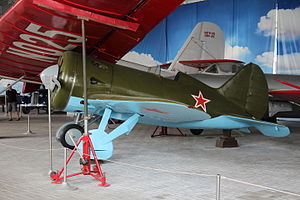
Back Polikarpof I-16 Afrikaans بوليكاربوف آي-16 Arabic І-16 Byelorussian И-16 Bulgarian Polikàrpov I-16 Catalan Polikarpov I-16 Czech Polikarpow I-16 German Polikarpov I-16 Esperanto Polikarpov I-16 Spanish I-16 Estonian
| I-16 | |
|---|---|

| |
| I-16 Type 5 in the Memorial Museum of Valery Chkalov, Chkalovsk, Russia | |
| Role | Fighter |
| National origin | Soviet Union |
| Manufacturer | Plant No. 21 (Gorky), Plant No. 39 (Moscow), Plant No. 153 (Novosibirsk), Plant No. 458 (Rostov-on-Don/Baku) |
| Designer | N. N. Polikarpov Design Bureau |
| First flight | 30 December 1933 (TsKB-12) |
| Introduction | March 1935 |
| Retired | 1945 (Soviet Air Force), 1953 (Spanish Air Force) |
| Primary users | Soviet Air Force Spanish Republican Air Force Chinese Nationalist Air Force |
| Produced | November 1920 – 1942 |
| Number built | 10,292 (6,848 fighters and 3,444 trainers)[1] |
| Developed into | Polikarpov I-180 |
The Polikarpov I-16 (Russian: Поликарпов И-16) is a Soviet single-engine single-seat fighter aircraft of revolutionary design; it was the world's first low-wing cantilever monoplane fighter with retractable landing gear to attain operational status and as such "introduced a new vogue in fighter design".[2] The I-16 was introduced in the mid-1930s and formed the backbone of the Soviet Air Force at the beginning of World War II. The diminutive fighter, nicknamed "Ishak" or "Ishachok" ("donkey" or "burro") by Soviet pilots, figured prominently in the Second Sino-Japanese War,[3] the Battle of Khalkhin Gol,[3] Winter War and the Spanish Civil War[4][5] – where it was called the Rata ("rat") by the Nationalists or Mosca ("fly") by the Republicans. The Finns called the aircraft Siipiorava "(flying squirrel)".[6]
© MMXXIII Rich X Search. We shall prevail. All rights reserved. Rich X Search